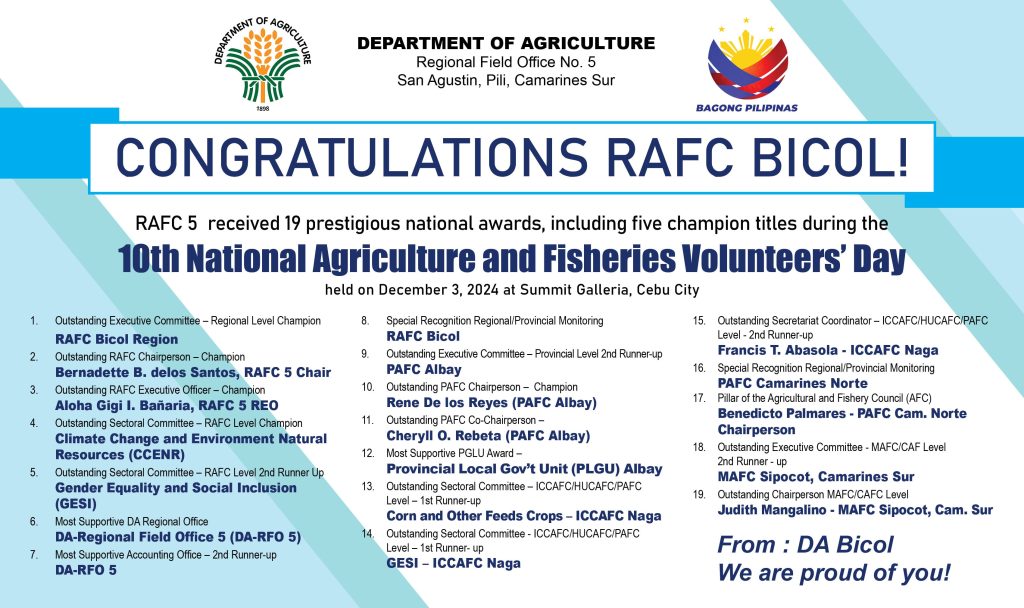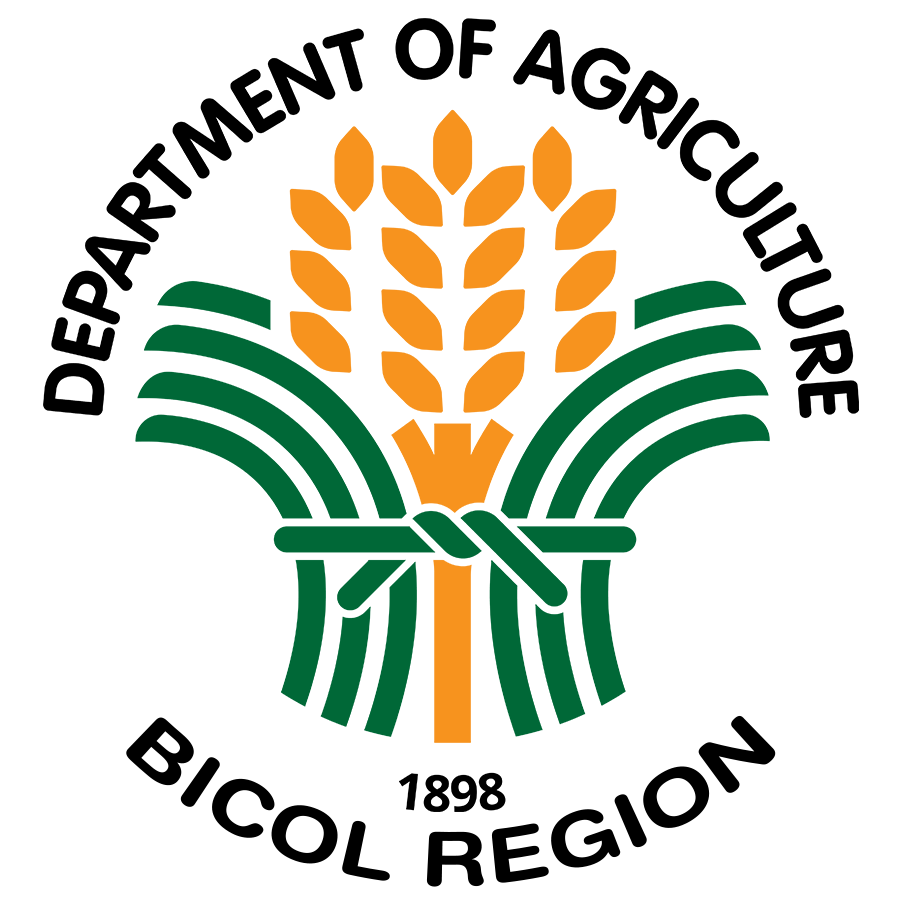
PCAF MANDATE AND FUNCTIONS, VISION, MISSION, GUIDING PRINCIPLES AND STRATEGIC DIRECTIONS
The Philippine Council for Agriculture and Fisheries was created out of the consolidation of two agencies under the Department of Agriculture (DA) – the National Agricultural and Fishery Council (NAFC) and the Livestock Development Council (LDC) by the virtue of the approval of the Rationalization Plan on June 26, 2013. Implementation of the Rationalization Plan, however, commenced in January 2015 pursuant to the inclusion of the agency’s dedicated budget in the 2015 General Appropriations Act (GAA).
The consolidation of these agencies is pursuant to Executive Order No. 366, Series of 2004 directing a strategic review of the operations and organizations of the Executive Branch and providing options and incentives for government employees who may be affected by the rationalization of the functions and agencies of the Executive Branch.
MANDATE
EO 116 mandated the NAFC to:
– Act as advisory body to the Department of Agriculture (DA) to ensure the success of its programs and activities; and
– Establish nationwide network of agricultural and fishery councils to serve as the forum for consultative and continuing discussions within agriculture and fisheries sectors. By virtue of DA
Administrative Order No. 6 or the Implementing Rules and Regulations of RA 8435, the NAFC serves as Secretariat to the National Agriculture and Fisheries Council (NAF Council) which is mandated to:
– Assist the DA in the broad-based monitoring and coordination of the agriculture and fisheries modernization process; and
– Serve as integrative and consultative structure for inter-agency and intersectoral collaboration in agriculture and fisheries modernization.
PD 914 mandated LDC to:
– Serve as the policy-making body for the livestock and poultry sector of the DA.
FUNCTIONS
Based on the above mandates and as stipulated in the approved rationalization plan, PCAF has the following functions:
– Serve as DA’s focal agency in private-public partnership in policy development;
– Serve as consultative/feedback mechanism on the policies, plans and programs of the DA;
– Monitor agriculture and fishery programs of all government agencies;
– Assist the DA in advocacy work among concerned government agencies;
– Help DA in mobilizing and evaluating the contributions of other agencies to agriculture and fishery modernization. This is part of PCAF’s monitoring functions;
– Promote consensus on, and support for national and local budgets for agriculture and fisheries. This will be the domain of the NAF Council specifically through the NAF Council Budget Committee;and
– Provide technical leadership, guidance and support for the continued development of the nationwide network of AFCs, NSCs and the NAF Council not only as consultative networks, but as partners in the execution of agency functions.
Agriculture and Fishery Council Mandates, Functions, Mission and Vision and Guiding Principles
The AFCs shall assume and/or be guided upon by the above mandates, functions, vision, mission and guiding principles.
In addition, and in the spirit of participatory governance, the AFCs shall also be guided by the following principles: broad based participation, private sector-led development, sustained volunteerism, shared vision, efficiency and effectiveness, equity, transparency, accountability, integrity, responsiveness and adherence to the rule of law.
Organization, Composition, Roles and Functions and Officers and Members
Organization
– The AFCs shall be organized at the regional, provincial, city and municipal levels as follows:
1. Regional Agricultural and Fishery Council (RAFC);
2. Provincial Agricultural and Fishery Council (PAFC);
3. Highly Urbanized City Agricultural and Fishery Council (HUCAFC);
4. Independent Component City Agricultural and Fishery Council (ICCAFC);
5. City Agricultural and Fishery Council (CAFC); and
6. Municipal Agricultural and Fishery Council (MAFC).
At the RAFC level, an Executive Committee (ExeCom) shall be organized to facilitate decision-making and act on urgent matters as well as handle crisis management. ExeCom may be organized at the local level.
At each AFC level, the following sectoral committees shall be organized:
1. Committee on Poultry, Livestock and Feed Crops;
2. Committee on Fisheries and Aquaculture;
3. Committee on Food Staples;
4. Committee on Fruits and Vegetables;
5. Committee on Commercial Crops;
6. Committee on Agricultural Mechanization;
7. Committee on International Trade;
8. Committee on Climate Change;
9. Committee on Women; and
10. Committee on Youth.
The Council may also create other sectoral committees related to agriculture and fisheries deemed necessary at their level, such as: Committee on Indigenous Peoples, Environment, etc.
Composition of AFCs–
The AFCs shall be composed of:
a. Stakeholder organizations of agriculture and fisheries including allied industries and services from the private sector. These include nongovernment organizations, people’s organizations, and civic groups; academe; and business organizations;
b. Concerned agencies from the government sector. These include DA and its attached agencies, bureaus and corporations, other government agencies and academe.
Individuals may also join the Council. An individual qualified to become a member should be involved in agriculture and fisheries sector including allied industries and services. He/she should not be a member of any organization already represented in the Council. He/she must possess an expertise that will contribute to the agricultural and fishery sector in general and benefit the Council in particular (e.g. former Chairpersons of the Council, professionals, entrepreneurs, etc.) and willing to share his/her time, talent and resources to champion agricultural and fishery development.
The composition of the AFCs is as follows:
1. Regional Agricultural and Fishery Council (RAFC) – This Council shall be composed of Chairpersons/Presidents or Representatives of region-wide agricultural and fishery organizations and other concerned institutions/CSOs, PAFC Chairpersons, HUCAFC Chairpersons, ICCAFC Chairpersons, individuals and government sector representatives;
2. Provincial Agricultural and Fishery Council (PAFC) – This Council shall be composed of Chairpersons/Presidents or Representatives of province-wide agricultural and fishery organizations and other concerned institutions/CSOs, MAFC and CAFC Chairpersons, Provincial Fisheries and Aquatic Resource Management Council (FARMC) Chairpersons, individuals and government sector representatives;
3. Highly Urbanized City Agricultural and Fishery Council (HUCAFC) – This Council shall be composed of Chairpersons/Presidents or Representatives of city-wide agricultural and fishery organizations and other concerned institutions/CSOs, City FARMC Chairperson, representatives from the District, individuals and government sector representatives;
4. Independent-Component City Agricultural and Fishery Council (ICCAFC) – This Council shall be composed of Chairpersons/Presidents or Representatives of city-wide agricultural and fishery organizations and other concerned institutions/CSOs, CFARMC Chairperson, representatives from the Barangay, individuals and government sector representatives;
5. City Agricultural and Fishery Council (CAFC) – This Council shall be composed of Chairpersons/Presidents or Representatives of city-wide agricultural and fishery organizations and other concerned institutions/CSOs, CFARMC Chairperson, representatives from the Barangay, individuals and government sector representatives; and
6. Municipal Agricultural and Fishery Council (MAFC) – This Council shall be composed of Chairpersons/Presidents or Representatives of municipal-wide agricultural and fishery organizations and other concerned institutions/CSOs, Municipal FARMC Chairperson, representatives from the Barangay, individuals and government sector representatives.
Membership Representation–
Membership of the AFCs should be broad-based. Private sector representation shall be at leastsixty (60) percent of the total membership. The rest shall be from the government sector to be determined by the Council. This may include one representative from any of the agencies/entities, where and when applicable, as specified in Annex A. Should the government membership exceeds forty (40) percent, the council may opt to consider other government representatives on an on-call basis as resource persons.
Roles of AFCs –
The AFCs shall have the following roles:
At the regional and local levels, AFCs take on the general role of being the frontline mechanisms for private sector participation in the development processes in agriculture and fisheries.
Specifically, AFCs as participatory mechanisms shall have the following roles:
1. Advisory bodies of the DA and LGUs to ensure the success of agricultural and fishery programs and projects;
2. Focal entities of government and private sector partnership for the continuing discussion of development problems, issues and concerns facing the agriculture and fisheries sector with the ultimate aim of finding solutions, giving policy/program recommendations and facilitating feedback and information flow within the sector; and
3. Consultative, integrative, coordinative and monitoring bodies for regional and local agricultural and fishery initiatives.
Functions of AFCs-
The AFCs shall perform the following functions:
1. Facilitate and/or conduct consultationson agricultural and fishery policy issues and concerns;
2. Participate in regional and local policy development, planning and budgeting processes, implementation and/or coordination of local agricultural and fishery plans, programs and projects;
3. Promote consensus on, and support for, regional and local budgets for agriculture and fisheries and assist the DA and/or LGU in other advocacy works with concerned government agencies and stakeholders; and
4. Monitor and evaluate agriculture and fishery sector-related policies, programs and projects at the regional and local levels; 5. Select and appoint the Chairpersons of the Sectoral and Working Committees.
For creative and innovative purposes, the roles and functions of the AFCs may be comprehensively interpreted as the VOICE and BRIDGES of the local agriculture and fisheries sector.
As the VOICE, the AFCs shall serve as:
– Vehicle for participation
– Conducts monthly meetings to discuss and resolve problems, issues and concerns confronting agriculture and fisheries
– Recommends programs & projects based on people’s/community’s needs
– Brings to the attention of concerned agencies critical information that affects program & project implementation
– Opens up opportunities for market, livelihood and personal growth
– Endorses projects for funding
– Undertakes promotional activities such as agri-fairs and market promotion activities
– Information source
– Generates and accesses international, national and local agricultural information that are critical to facilitate discussions in the AFC
– Channel of communication
– Be the channel for continuing communication/discussions between the government and the private sector, both national and local, and among stakeholders/sectors
– Enabler for community and individual stakeholder to influence and share control over development initiatives
– Recommends programs, projects and policies based on people’s/community’s needs
– Assists in the planning and budgeting of DA and LGU
– Identifies and assesses diverse needs and resources of the area, in consultation with government and NGOs to bring about collective action for agri-fisheries development
As BRIDGES, the AFCs shall serve as:
– Builder of support for agriculture and fisheries;
– Resource generator;
– Integrator of development initiatives and concerns;
– Designer of agriculture and fisheries sectors consultation activities;
– Governance mechanism to stimulate responsiveness, openness, transparency and accountability;
– Evaluator of programs, policies and projects, and gives feedback on how these are implemented and how they affect the lives of community members.
– Strategic partner of the regional and local governments and the PCAF to ensure success in the implementation of agricultural and fishery policies, programs and projects.
Forms:
